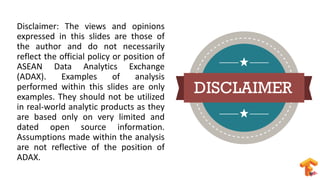Explore and have fun with TensorFlow: An introductory to TensorFlow
- 2. Disclaimer: The views and opinions expressed in this slides are those of the author and do not necessarily reflect the official policy or position of ASEAN Data Analytics Exchange (ADAX). Examples of analysis performed within this slides are only examples. They should not be utilized in real-world analytic products as they are based only on very limited and dated open source information. Assumptions made within the analysis are not reflective of the position of ADAX.
- 3. Agenda • Deep Learning Libraries • What is TensorFlow? • Why it is called TensorFlow? • Steps to start TensorFlow • TensorFlow Graph • Variables & Placeholders • Gradient • TensorFlow Architecture • Demo
- 4. About me Poo Kuan Hoong, http://www.linkedin.com/in/kuanhoong • Senior Manager Data Science • Senior Lecturer • Chairperson Data Science Institute • Founder R User Group & TensorFlow User Group • Speaker/Trainer • Senior Data Scientist
- 5. TensorFlow & Deep Learning Malaysia Group The TensorFlow & Deep Learning Malaysia group's aims are: • To enable people to create and deploy their own Deep Learning models built using primarily TensorFlow or other Deep Learning libraries. • To build the key skill sets for this group from the combination of both beginner and intermediate models as well as advancing to the next level • A knowledge sharing and presentations platform in relation to the cutting edge deep learning research papers and techniques.
- 11. What is TensorFlow? • URL: https://www.tensorflow.org/ • Released under the open source license on November 9, 2015 • Current version 1.2 • Open source software library for numerical computation using data flow graphs • Originally developed by Google Brain Team to conduct machine learning and deep neural networks research • General enough to be applicable in a wide variety of other domains as well • TensorFlow provides an extensive suite of functions and classes that allow users to build various models from scratch.
- 13. TensorFlow architecture • Core in C++ • Low overhead • Different front ends for specifying/driving the computation • Python, C++, R and many more
- 14. CPU - GPU • In TensorFlow, the supported device types are CPU and GPU. They are represented as strings. For example: • "/cpu:0": The CPU of your machine. • "/gpu:0": The GPU of your machine, if you have one. • "/gpu:1": The second GPU of your machine, etc.
- 16. Why it is called TensorFlow? • TensorFlow is based on computation data flow graph • TensorFlow separates definition of computations from their execution
- 19. TensorFlow Graph • To get the value of a • Create a session, assign it to variable ‘sess’ so we can call it later • Within the session, evaluate the graph to fetch the value of a import tensorflow as tf a = tf.add(3, 5) sess = tf.Session() print (sess.run(a)) sess.close() • A Session object encapsulates the environment in which Operation objects are executed, and Tensor objects are evaluated. 3 5 add 8
- 21. Variables • Variables to hold and update parameters. • Variables are in-memory buffers containing tensors. • Must be explicitly initialized and can be saved to disk during and after training
- 22. Placeholder • A placeholder is simply a variable that will be assigned data to at a later date. • It allows operations to be created and computation graph to be built, without needing the data.
- 23. Learn Parameters: Optimization • The Optimizer base class provides methods to compute gradients for a loss and apply gradients to variables. • A collection of subclasses implement classic optimization algorithms such as GradientDescent and Adagrad. • TensorFlow provides functions to compute the derivatives for a given TensorFlow computation graph, adding operations to the graph.
- 25. TensorBoard • Visualize your TensorFlow graph • Plot quantitative metrics about the execution of your graph • Show additional data like images that pass through it
- 26. TensorFlow Models https://github.com/tensorflow/models Models • adversarial_crypto: protecting communications with adversarial neural cryptography. • adversarial_text: semi-supervised sequence learning with adversarial training. • attention_ocr: a model for real-world image text extraction. • autoencoder: various autoencoders. • cognitive_mapping_and_planning: implementation of a spatial memory based mapping and planning architecture for visual navigation. • compression: compressing and decompressing images using a pre-trained Residual GRU network. • differential_privacy: privacy-preserving student models from multiple teachers. • domain_adaptation: domain separation networks. • im2txt: image-to-text neural network for image captioning. • inception: deep convolutional networks for computer vision.
- 27. TensorFlow Serving • Flexible, high-performance serving system for machine learning models, designed for production environments. • Easy to deploy new algorithms and experiments, while keeping the same server architecture and APIs
- 28. Take away • There are 4 steps: • Step 1: Assemble the graph – • 1. Define placeholders for input and output • 2. Define the weights • 3. Define the inference model • 4. Define loss function • 5. Define optimizer • Step 2: Train the Model • Step 3: Optimize the Model The world has too many problems and not enough people solving them.






























